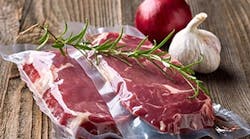DSM, Amsterdam, is teaming up with plastic recycling technology specialist APK, Merseburg, Germany, to develop new strategies to increase the recycling of multilayer food packaging films.
[pullquote]
The use of such films, along with packaging generally, has been increasing over the last decade. According to the Eurostat statistics body of the European Union (EU), each EU citizen produces 166.3 kg of packaging waste per year.
However, while common recycling technologies can cope with many individual plastic varieties, their integration into multiple layers poses a number of problems — not least at the mechanical separation stage. So, multilayer films in post-consumer waste — a package of potato chips can contain up to seven, and up to 16 in other food applications — are either incinerated or recycled to re-granulates with a relatively poor quality, limiting their future to a small range of applications. The challenge, therefore, is to find ways of achieving higher quality re-granulates for use in more applications.
Figure 1. Multi-layer barrier films increase significantly the shelf-life of food products. Source: DSM. (sent as DSM multilayer.jpg)
Legislation is one of the drivers behind this search. Southeast Asia, for example, plans to ban specific types of plastic packaging in the next two years. In the EU, the target for plastics recycling is 60% by 2030. At the same time, major manufacturers are becoming more wedded to the idea of a circular economy for their products and processes, while consumers — especially in more-developed economies — increasingly are demanding the use of more recycled materials.
Many multilayer barrier films for food packaging consist of a combination of polyethylene (PE) and polyamide 6 (PA6), where PE acts as a barrier for moisture and PA6 as a barrier for oxygen, together significantly extending the shelf life of the packaged food.
Such packaging can’t be produced just with PE film, because the layer thicknesses to achieve sufficient barrier properties would become too high. The addition of PA6 reduces the total layer thickness significantly and improves the mechanical integrity of the film, resulting in less rupture of the films during transportation and logistics. This leads to a lower food waste percentage as well as a significantly better carbon footprint in a life cycle analysis (LCA).
APK and DSM will address the end-of-life stage of the LCA of a multilayer PE/PA6 packaging film using APK’s Newcycling process, a technique that enables recovery of high-quality re-granulates with properties close to virgin plastics from complex mixtures and multilayer composites, i.e., multilayer barrier packaging. This isn’t possible with conventional recycling systems.
“Moreover, the Newcycling process is highly cost-efficient and offers a competitive, sustainable material source. The re-granulates, generated from multilayer PE/PA6 packaging waste, can be used again in demanding flexible packaging, which contributes to the target of a circular economy,” explains Florian Riedl, APK’s head of business development.
APK currently is building a plant at its Merseburg headquarters, which will use the Newcycling process to recycle multilayer PE/PA6 packaging. Startup is slated for later this year.
The company’s initial recycling focus was on PE, polypropylene and PA, while the same technology could also can handle polyethylene terephthalate, polystyrene, polylactic acid and even pure aluminium.
Newcycling itself is a solvent-based physical process. In the case of PE/PA film mixtures, for example, the first step is solvent extraction. This is followed by the separation of the solid PA fraction from the now solvent-borne PE fraction. The PA fraction is then washed and undergoes a second separation step to remove any remaining liquid before drying and finally extrusion/pelletizing — leaving PA pellets with properties very close to the virgin material. Meanwhile, the solvent-borne PE goes through a drying step, separating solids for extrusion/pelletization from the solvent. The solvent itself is then condensed and recycled back to the first step of the process.
As well as the work with DSM and PE/PA6 packaging film, APK also is planning to increase capacity for the separation of post-industrial use PE/PA multilayer waste at Merseburg in the fourth quarter. Next year will focus on a production campaign aimed at increasing the recycling post-consumer waste and other multilayer structures, also at Merseburg. In addition, the company is considering starting up a second facility, either at another location in Europe or in Asia. Production at this plant is slated to begin in late 2020.


